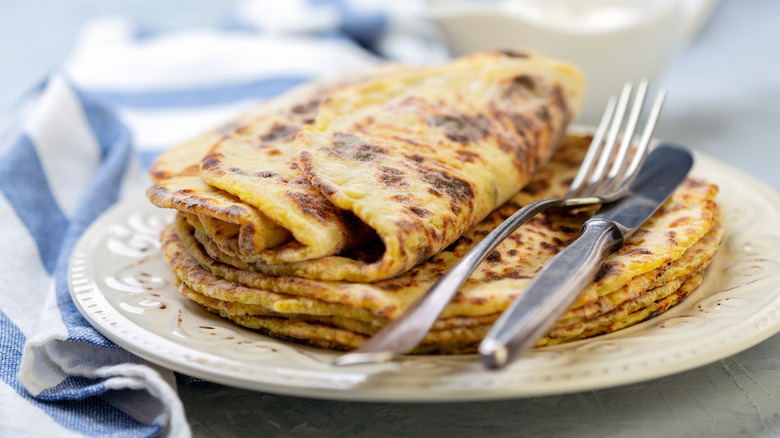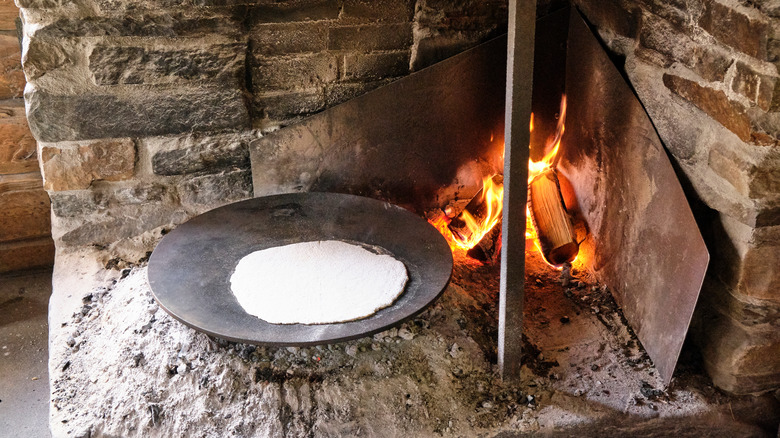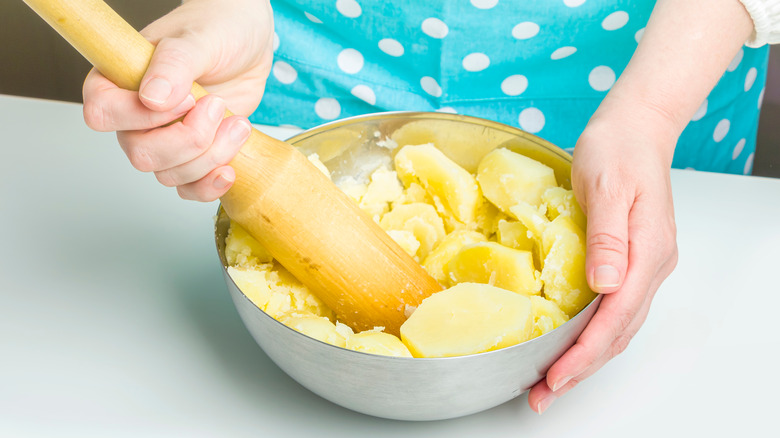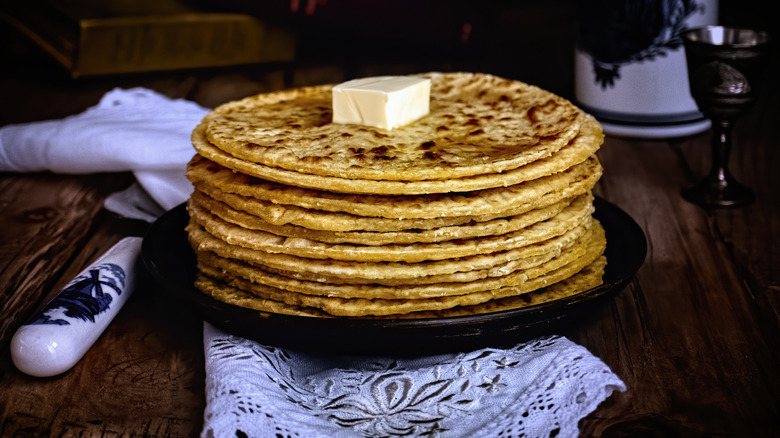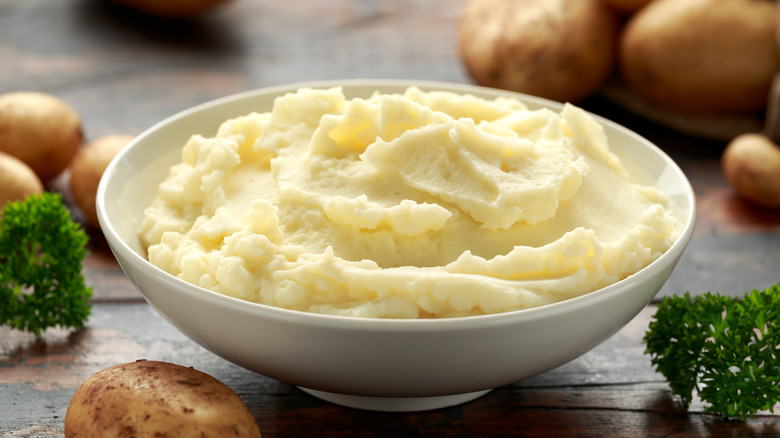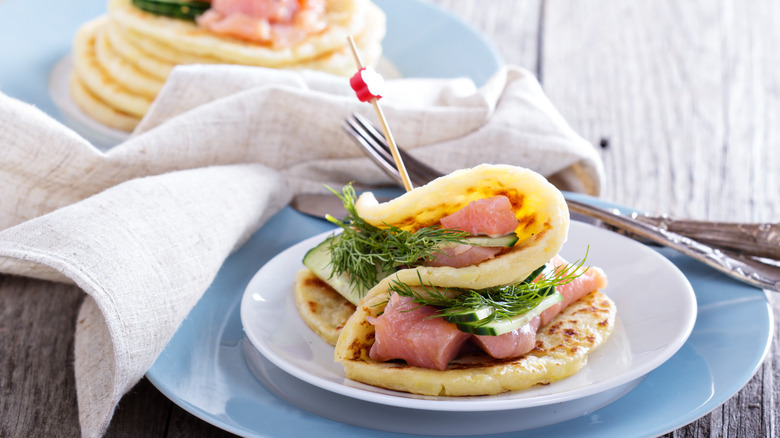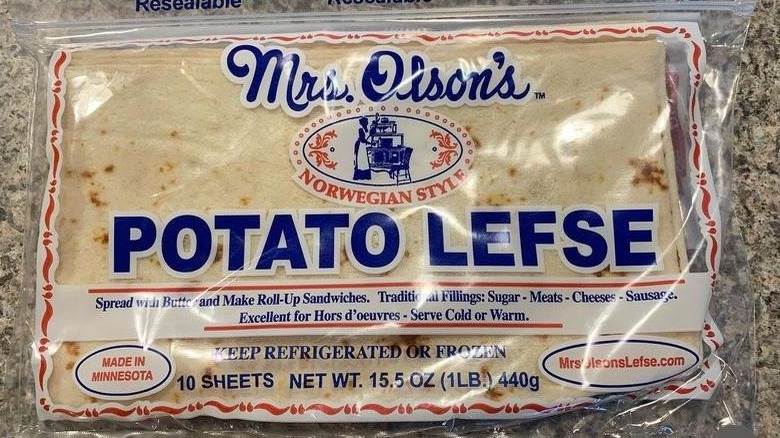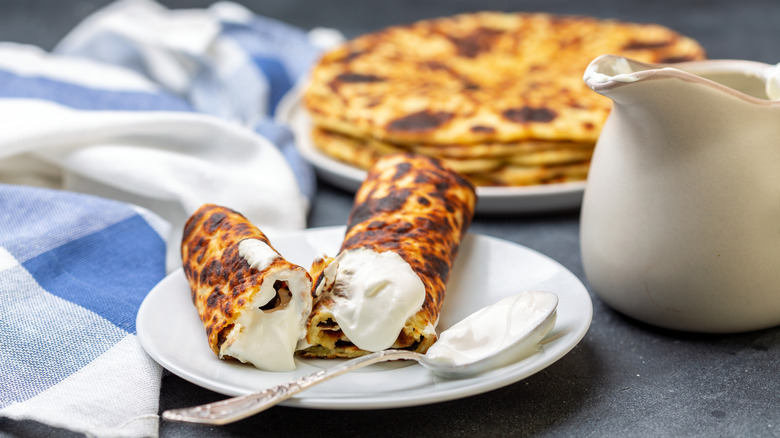Lefse: The Versatile Norwegian Flatbread You Should Know
Hailing from Norway, lefse is a soft flatbread that dates back centuries (per Planet Norway). Norwegians and Norwegian Americans enjoy homemade lefse served with morning coffee or hot chocolate. Similar to French crêpes, chapati flatbreads, and Mexican flour tortillas, these doughy pieces of goodness are enhanced by dollops of fancy butter and sprinklings of sugar and cinnamon (via 196 Flavors). When served piping hot and fresh off a griddle, you'll be eagerly reaching for your next serving.
An original lefse recipe was made by Vikings and resulted in a large cracker that could be stored for years, according to Farmer's Almanac. During holidays, packaged lefse is now found in specialty grocery stores and can be purchased from online Norwegian culinary shops. When dried, Planet Norway instructs lefse can be eaten like a cracker or reconstituted in water. The recipe itself is simple to make and can be served as a standalone snack or served as a savory meal accompaniment.
What exactly is lefse?
Traditional Norwegian lefse look similar to pancakes, according to Planet Norway. The first lefse recipes would use various types of flour such as milled barley, oats, buckwheat, wheat, and rye. Selected ingredients can be blended with milk, cream, butter, or water, depending on the desired taste. Most lefse is unleavened except for tykklefse, which calls for baking soda or powder, and the slightly fluffy krotakaka, which includes yeast (per Large Norwegian Encyclopedia).
Before the advent of electricity, Visit Norway explains lefse was cooked over open flames on a cast iron skillet. NPR suggests that the most successful lefse recipes are a combination of technique and the right equipment: Lefse dough needs to be flattened and rolled onto generously floured surfaces, and the uncooked pieces must be formed into even circles. Once cooked, the soft, warm treats are often coated with a bit of sweetness like sprinkled sugar, a swab of butter, or a spoonful of fresh fruit jam.
How to prepare lefse
According to Planet Norway, potatoes are now one of the ingredients most commonly used to make lefse dough. Leftover boiled potatoes are combined with cream or half and half. If you're pressed for time, potatoes can be boiled in advance and passed through a ricer or sieve, then blended with cream and butter until smooth, instructs the The Washington Post. The next day, flour is added to the chilled mixture, and the dough is kneaded until smooth.
Once dough circles are rolled, lefse should be cooked on a hot surface until lightly browned. (If you have a griddle, lefse is one of the best uses for it.) 196 Flavors adds that long wooden tongs can be used to carefully flip the lefse and place the uncooked side down. When your batch is ready, the finished lefse can be stacked and separated by parchment paper or covered with a clean cloth and kept warm until ready to serve.
Fresh vs. dried lefse
Historically, Norwegians dried batches of fresh lefse and would save it to sustain themselves through hard Scandinavian winters (via Life in Norway). When hungry or craving sustenance, the dried lefse could be rehydrated before serving, according to Planet Norway.
While modern technology, refrigeration, and a global food supply have eliminated the need for such kind of food preparation and planning, dried lefse can still be found. Several Norwegian food brands sell both dried and fresh lefse in packages.
As with most baked goods, fresh is often best. The aroma of buttery potato dough browning on a hot griddle is enticing. But it isn't always convenient to assemble dough, roll out perfect shapes, and wait for it to cook — especially when those hunger pangs strike. Instead, consider making lefse in batches and storing them for those moments you're trying to bring hygge into your home. When properly frozen, Minnesota Uncorked advises, fresh lefse can be kept up to a year.
What does lefse taste like?
If you have tucked into a steaming, comforting bowl of any smashed potatoes recipe that has been specially prepared with ample portions of butter and cream, you can imagine how good lefse tastes. On its own, lefse is a robust yet creamy tortilla-style flatbread with hints of buttery perfection. The heat from warm lefse will enhance any toppings you choose to add, and the aromatics and flavors will play well with the recipe's simplicity.
It's because of this relatively neutral flavor that lefse lends perfectly to a variety of savory, salty, and sweet combinations. Just like a flour tortilla or basic crêpe, lefse is a vehicle for the ingredients and fillings you choose. 196 Flavors recommends pairing lefse recipes with butter. Just like that perfect bowl of mashed potatoes, the right dairy ingredients can help bring out subtle, smooth notes of potatoes; this taste is only heightened when lefse is heated prior to serving.
A versatile treat
Lefse is delicious when served hot. Some of the more popular ways to eat lefse include slathering the bread with butter, packing it with fillings, or coating the flatbread with syrup or sugar. Lefse can be enjoyed just like a French toast stuffed with hazelnut-chocolate spread, or the bread can be stuffed with sweetened ricotta and topped with lingonberries, blueberries, and cloudberries. Of course, a freshly whipped dollop of sweet cream on top is never a bad idea.
Lefse can also be filled with savory meats, cheeses, and fish (per Planet Norway). Savory lefse dishes often include Norwegian cheeses like mysost, prim, goat, or sheep cheeses, and can include smoked and pickled fish (via Visit Norway). Fishes like lutefisk, cured salmon, and smoked fish are popular choices for lefse wraps, but lefse wraps can be stuffed with vegan ingredients, too. If you're unsure where to begin, Fjord Tours suggests viewing lefse as a "bread plate" and topping your piece with savory foods like ham and cheese or enjoying it as a sweet treat with coffee.
Where to find packaged lefse
Norwegian immigrants brought their culinary traditions with them to America (via FamilySearch). Norwegian American communities maintain strong ties to their cultures and traditions, and Nordic food stores, restaurants, and bakeries abound (per Eater). Unfortunately, outside of these communities, commercially produced lefse can be difficult to find.
American Viking Soul Food, Mrs. Olson's Scandanivian Potato Lefse, Norsland Lefse, and Vestlands Lefse sell lefse year-round. Sadly, most commercial lefse brands can't compare to freshly made lefse; they don't always use the best oils for cooking, replace butter with vegetable shortening, and substitute cream or half and half with milk powder. If you didn't grow up with a Norwegian grandmother spoiling you with morning cinnamon and sugar lefse, maybe you won't notice the difference.
Can't find a Scandinavian or Norwegian bakery in your neighborhood? Try to make this specialty for yourself. After whipping up a batch, place cooled lefse between parchment paper and refrigerate or freeze them for later enjoyment.
Other varieties of lefse
According to Planet Norway, every region of Norway has its own take on lefse. Visit Norway details a dozen different regional styles of lefse, including pjalt, klenning, and krinalefse. Potetlefse is stuffed with potatoes, while møsbrømlefse is served with a cheese spread and topped with berries, fruit slices, preserves, or syrup.
Some lefse recipes use eggs or different flours. Hardanger lefse, which BigOven explains can be stored safely on shelves for months, is usually made with oat flour, buttermilk, and honey. Nordlandslefse is a thicker version of the original lefse recipe but contains a buttercream filling and, as North Wild Kitchen explains, usually has horn salt as a leavening ingredient. Gnikkakalefse is a crunchier version of the treat; the flattened dough is coated in a salty milk wash and then fried. Since variations of this bready treat are endless, feel free to experiment at home.
